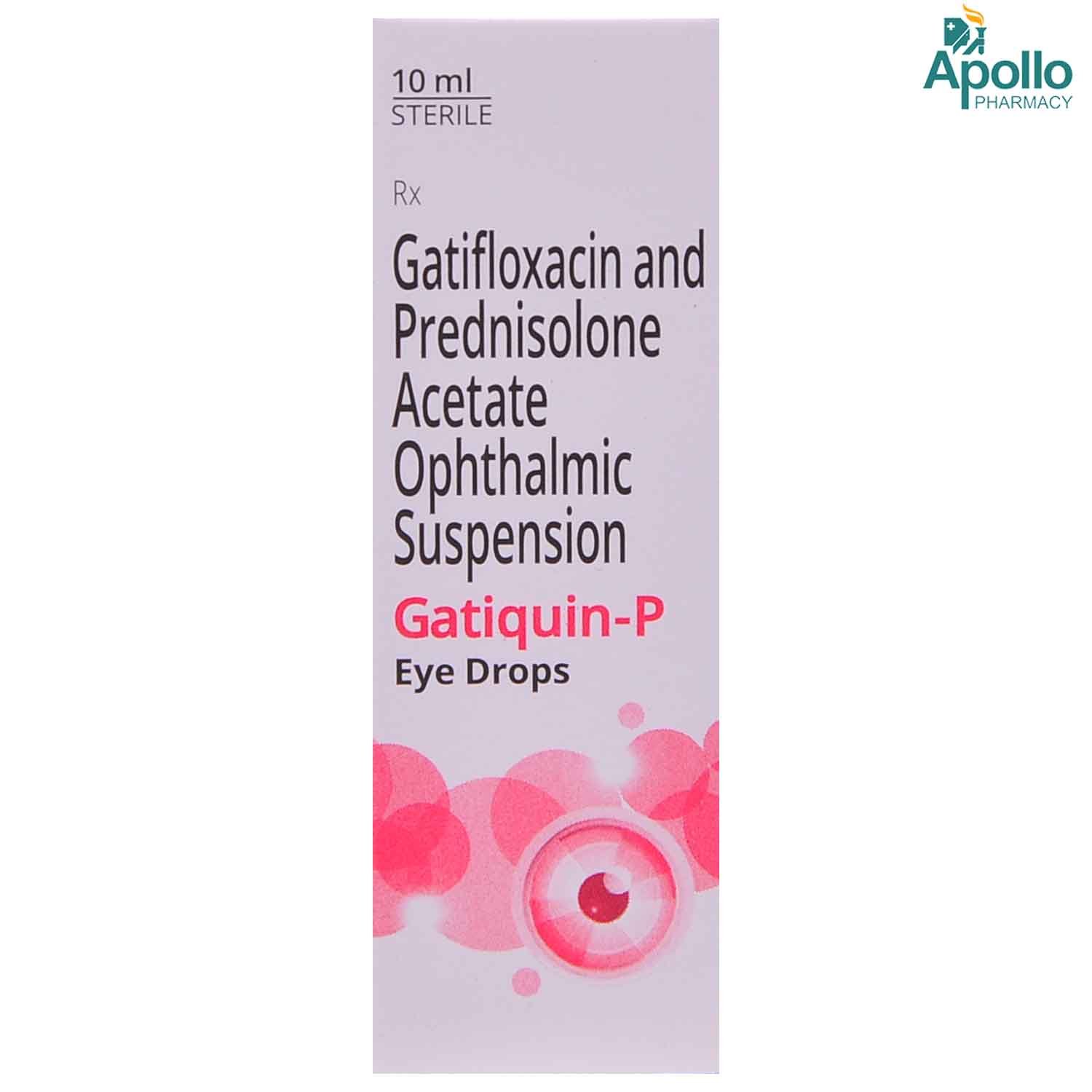Gatiquin P Eye Drop 10 ml
MRP ₹188
(Inclusive of all Taxes)
₹28.2 Cashback (15%)
Selected Pack Size:10 ml
10 ml ₹169.2
(₹16.92 per ml)
In Stock
5 ml ₹165.4
(₹33.08 per ml)
In Stock
Provide Delivery Location
Online payment accepted
 Prescription drug
Prescription drugWhats That
Composition :
Manufacturer/Marketer :
Consume Type :
Expires on or after :
Return Policy :
About Gatiquin P Eye Drop
Gatiquin P Eye Drop belongs to a group of medications called ‘Antibiotics and Corticosteroids’ used to treat bacterial eye infections or eye discomfort, especially in patients who have undergone eye surgeries. It also decreases the risk of eye infections such as conjunctivitis (inflammation of the conjunctiva) and other inflammatory conditions of the eye (cornea, iris, and connective tissue) in postoperative patients.
Gatiquin P Eye Drop is a combination of two medicines: Gatifloxacin and Prednisolone. Gatifloxacin is an antibiotic that acts by interfering with the formation of essential proteins required for bacterial growth. Prednisolone is a steroid that reduces inflammation and symptoms associated with infection such as redness and irritation. It works by inhibiting the chemicals such as prostaglandins that cause inflammation.
Gatiquin P Eye Drop is available for external use only. You should take this medicine as prescribed by your doctor. The common side-effects of Gatiquin P Eye Drop are application site reactions such as redness, burning or stinging sensation, watery eyes, and blurred vision. These side-effects are mild and temporary. It may also cause inflammation of the cornea (clear outer layer of the eye), which is a serious side-effect and may cause vision problems. If any of these side-effects persist, consult your doctor immediately.
Inform your doctor before using Gatiquin P Eye Drop if you have allergic reactions to medicines, tuberculosis, damaged cornea, ulcers in the eye, eye infection and producing pus, open lesions in the eye and glaucoma (a condition where the pressure inside the eye is increased). Pregnant and breastfeeding women should consult their doctor before starting Gatiquin P Eye Drop. This medicine may cause temporary blurred vision; hence drive only when you are alert and have clear vision.
Uses of Gatiquin P Eye Drop
Directions for Use
Key Benefits
Gatiquin P Eye Drop is a combination of two medicines: Gatifloxacin and Prednisolone. Gatifloxacin is a fluoroquinolone and broad-spectrum antibiotic. It can act against both gram-positive and gram-negative bacteria. It acts by interfering with the formation of essential proteins required for bacterial growth. Prednisolone is a corticosteroid with anti-inflammatory properties and acts by inhibiting the chemicals such as prostaglandins that cause inflammation. It reduces symptoms associated with infection, such as redness and irritation of the eye and decreases the risk of infections.
Storage
Drug Warnings
Before taking Gatiquin P Eye Drop, inform your doctor if you have vision problems, severe pain in the eye, ulcers in the eye, glaucoma (raised pressure in the eye), eye injury, or have undergone eye surgery or using any other eye drops or eye ointment. Do not use eye drops for longer than recommended by your doctor as it may increase the risk of cataracts (clouding of the eye) and increase the risk of a second infection. So, inform your doctor immediately if you notice any persistent visual disturbances while using this medicine. Do not wear contact lenses while using Gatiquin P Eye Drop.
Drug-Drug Interactions
Drug-Drug Interactions
Login/Sign Up
Coadministration of Gatiquin P Eye Drop 10 ml with Rosiglitazone may sometimes affect blood glucose levels. Both low blood glucose and, less frequently, high blood glucose have been reported.
How to manage the interaction:
Although there is a possible interaction, Rosiglitazone can be taken with Gatiquin P Eye Drop 10 ml if prescribed by the doctor. Consult the prescriber if you experience symptoms such as nervousness, confusion, headache, dizziness, drowsiness, tremor, nausea, hunger, weakness, perspiration, palpitation, rapid heartbeat, increased urination, increased thirst, and increased hunger. Maintaining blood glucose levels is advised.
Taking Gatiquin P Eye Drop 10 ml and Disopyramide can increase the risk of irregular heart rhythms.
How to manage the interaction:
Taking Gatiquin P Eye Drop 10 ml and Disopyramide together is not recommended as it can possibly result in an interaction, it can be taken if your doctor has advised it. However, if you experience sudden dizziness, lightheadedness, fainting, shortness of breath, chest pain or tightness, rapid heartbeat, or memory loss, contact your doctor immediately. Do not discontinue any medications without consulting a doctor.
Co-administration of Dapagliflozin with Gatiquin P Eye Drop 10 ml may sometimes affect blood glucose levels. Both low blood glucose and, less frequently, high blood glucose have been reported.
How to manage the interaction:
Although there is a possible interaction, Gatiquin P Eye Drop 10 ml can be taken with Dapagliflozin if prescribed by the doctor. Consult the prescriber if you experience symptoms such as nervousness, confusion, headache, dizziness, drowsiness, tremor, nausea, hunger, weakness, perspiration, palpitation, rapid heartbeat, increased urination, increased thirst, and increased hunger. Maintaining blood glucose levels is advised. Do not discontinue the medication without consulting a doctor.
Taking Gatiquin P Eye Drop 10 ml with Bepridil can increase the risk or severity of irregular heart rhythms. The risk increases in patients with a history of heart illness or electrolyte imbalance.
How to manage the interaction:
Taking Gatiquin P Eye Drop 10 ml with Bepridil together can possibly result in an interaction, it can be taken if your doctor has advised it. However, if you experience sudden dizziness, lightheadedness, fainting, shortness of breath, chest pain or tightness, rapid heartbeat, or memory loss, contact a doctor immediately. Do not discontinue any medications without consulting a doctor.
Coadministration of Repaglinide with Gatiquin P Eye Drop 10 ml may sometimes affect blood glucose levels. Both low blood glucose and, less frequently, high blood glucose have been reported.
How to manage the interaction:
Although there is a possible interaction, Repaglinide can be taken with Gatiquin P Eye Drop 10 ml if prescribed by the doctor. However, consult the doctor if you experience unusual symptoms. Do not stop using any medications without first talking to your doctor.
Taking Gatiquin P Eye Drop 10 ml with Ziprasidone can increase the risk of irregular heart rhythm.
How to manage the interaction:
Taking Gatiquin P Eye Drop 10 ml with Ziprasidone together can possibly result in an interaction, but it can be taken together if prescribed by a doctor. However, consult your doctor if you experience sudden dizziness, lightheadedness, fainting, shortness of breath. Do not discontinue any medications without consulting a doctor.
Gatiquin P Eye Drop 10 ml may reduce the effectiveness tirzepatide and therby increase the blood glucose levels.
How to manage the interaction:
Close blood glucose monitoring is recommended when on treatment with Gatiquin P Eye Drop 10 ml along with tirzepatide.
Coadministration of Gatiquin P Eye Drop 10 ml with INSULIN HUMAN may sometimes affect blood glucose levels. Both low blood glucose and, less frequently, high blood glucose have been reported.
How to manage the interaction:
Although there is a possible interaction, INSULIN HUMAN can be taken with Gatiquin P Eye Drop 10 ml if prescribed by the doctor. Consult the prescriber if you experience symptoms such as nervousness, confusion, headache, dizziness, drowsiness, tremors, nausea, hunger, weakness, perspiration, palpitation, rapid heartbeat, increased urination, increased thirst, and increased hunger. Maintaining blood glucose levels is advised.
Taking Gatiquin P Eye Drop 10 ml with Dronedarone can increase the risk or severity of irregular heart rhythms. The risk increases in patients with a history of heart illness or electrolyte imbalance.
How to manage the interaction:
Taking Gatiquin P Eye Drop 10 ml with Dronedarone together is not recommedned as it can possibly result in an interaction, it can be taken if your doctor has advised it. However, if you experience sudden dizziness, lightheadedness, fainting, shortness of breath, chest pain or tightness, rapid heartbeat, or memory loss, contact your doctor immediately. Do not discontinue any medications without consulting a doctor.
Coadministration of Saxagliptin with Gatiquin P Eye Drop 10 ml may sometimes affect blood glucose levels. Both high blood glucose and, less frequently, low blood glucose have been reported.
How to manage the interaction:
Although there is a possible interaction, Saxagliptin can be taken with Gatiquin P Eye Drop 10 ml if prescribed by the doctor. Consult the doctor if you experience nervousness, confusion, headache, dizziness, drowsiness, tremors, nausea, hunger, weakness, perspiration, palpitation, rapid heartbeat, urination, thirst, and hunger. Monitoring blood glucose levels is advised. Do not discontinue any medications without first consulting your doctor.
Drug-Food Interactions
Drug-Food Interactions
Login/Sign Up
Diet & Lifestyle Advise
- Sleep for at least six to eight hours to rejuvenate your eyes naturally.
- Wash your eyes with clean water at least two to three times a day
- Manage stress, eat healthily, drink plenty of water, exercise regularly, and get plenty of sleep.
- Avoid alcoholic beverages as it can make you dehydrated and affect your sleep. This effect can also affect your body’s ability to fight off infections.
- Reduce screen time (by avoiding watching tv or phone) and use sunglasses while going out into the sunlight.
Side Effects of Gatiquin P Eye Drop
- Redness in the eye
- Burning or stinging sensation in the eye
- Watery eyes
- Blurred vision
- Inflammation of the cornea (severe)
Habit Forming
Therapeutic Class
All Substitutes & Brand Comparisons
RX
Gate P Eye Drop 10 ml
Ajanta Pharma Ltd
₹52
(₹4.69/ 1ml)
72% CHEAPERRX
Out of StockVatiflo-P Eye Drop
Vee Remedies
₹77.4
(₹6.97/ 1ml)
58% CHEAPERRX
Out of StockDrMpred-GT Eye Drop
₹50
(₹9.0/ 1ml)
46% CHEAPER
Drug-Diseases Interactions
Drug-Diseases Interactions
Login/Sign Up
FAQs
Drug-Drug Interactions Checker List
- CIPROFLOXACIN
- ENOXACIN
- LEVOFLOXACIN
- MOXIFLOXACIN
- RITONAVIR
- COBICISTAT
Special Advise
It is advised to contact your doctor if the infection symptoms persist or worsen after two weeks of treatment.
Disease/Condition Glossary
Bacterial eye infections: Bacterial eye infections are the common eye problems seen in a primary care setting. The common eye problems are conjunctivitis (inflammation of the conjunctiva), stye (bump on the eyelid), and keratitis (inflammation of the cornea). The risk for eye infection is high in post-operative patients or patients who have undergone Lasik, cataracts or other eye surgeries.

Have a query?
Alcohol
Safe if prescribed
Do not take alcohol while using Gatiquin P Eye Drop as it may affect your ability to fight infections.
Pregnancy
Consult your doctor
It is advised to consult your doctor if you plan to conceive or are already pregnant before starting Gatiquin P Eye Drop.
Breast Feeding
Consult your doctor
There are limited studies on how Gatiquin P Eye Drop affects breastfed infants. Please consult your doctor before taking Gatiquin P Eye Drop if you are breastfeeding.
Driving
Safe if prescribed
There are limited studies on how Gatiquin P Eye Drop affects breastfed infants. Please consult your doctor before taking Gatiquin P Eye Drop if you are breastfeeding.
Liver
Consult your doctor
Gatiquin P Eye Drop can be used for treating eye infections in patients with liver diseases.
Kidney
Consult your doctor
Gatiquin P Eye Drop can be used for treating eye infections in patients with kidney diseases.
Children
Safe if prescribed
Gatiquin P Eye Drop should be used with caution in children. It is not recommended for use in newborns.












